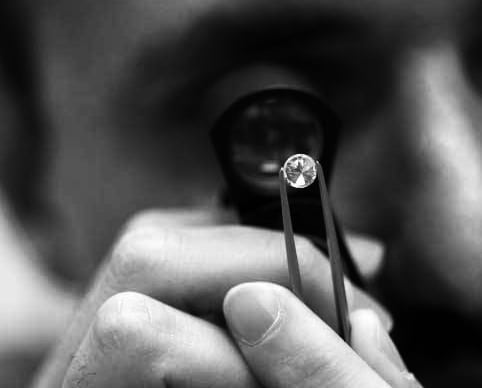More often than not, consumers say synthetic diamonds when they are actually referring to simulants. Regardless of the term, they think about substances that are used to manufacture Cubic Zirconia, YAG, White Sapphire or Moissanite. This has generated a lot of confusion regarding the authenticity of man made diamonds. Many companies refer to simulants as lab made diamonds, when, in reality, they are extremely different. Today we would like to address this confusion.
The term ‘synthetic’ is often used in order to describe fake diamonds such as Cubic Zirconia. In reality this term is misleading and inaccurate for the consumer. Synthetic, as an adjective, refers to products that are created artificially through chemical synthesis in order to resemble natural products. In the diamond industry, the term refers to the formation of compounds ‘through one or more chemical reactions involving simpler substances’. In other words, lab diamonds are not fake. They are not created through a chemical reaction, but through an accelerated crystal growth process, similar to the natural one. This means that man made diamonds are real diamonds, which were mined or lab created and refined in a laboratory.

In general, the properties of synthetic diamonds, which differ according to manufacturing process, are superior to those of naturally-formed ones. For example, thermal conductivity, electron mobility and hardness may have higher quality. Simulated diamond rings and other jewelry pieces are becoming increasingly popular. This is because the unique combination of low thermal expansion, high optical transparency and chemical stability has led to the production of superior gems. But it is not only the jewelry industry that benefits from superior lab created diamonds. Statistics actually show that roughly 98% of industrial grade diamonds are supplied with lab created ones.
The question now is, ‘do the origins of a diamond really matter?’ Technology has reached a point where it is possible to create synthetic diamond jewelry that are virtually impossible to distinguish from mined ones. In addition to this, jewelry such as lab created diamond rings, is cheaper. If you are planning on purchasing this type of gem in your hunt for spectacular jewelry, here are a few things you should know:
1. It is extremely difficult to tell the difference between fake diamonds and mined ones
If you will ask an expert or a legitimate source about a fake gem, he will tell you that it is almost identical to a real diamond. This is because both have the exact same chemical and physical properties. Keep in mind that diamonds which have undergone chemical transformations are named lab-grown or man-made diamonds.
2. Some Women Will Settle for Nothing Less than a Diamond
The distinction between real diamonds and lab created ones should be very clear. Diamonds have been on this earth for billions of years. Synthetics have been formed through various chemical processes. To call them real would be misleading. There is something infinitely fascinating about crystal clear diamonds, and some consumers will not settle for anything less. According to IDC’s Almor, synthetic diamonds put the price point in the center, and while this may be beneficial for lighter wallets, it takes the emotion out of purchasing a ring.
He believes that it is impossible to experience real love if you are not prepared to buy the real deal. Again, personal opinions vary, and because synthetic diamonds are equally beautiful to real ones, their authenticity may not matter.
3. Cubic Zirconia is Not a Syntehtic Diamond
Everybody knows what cubic zirconia is, but do they know what it isn’t? This substance was made to look like a diamond, but it does not have the same chemical composition. It is simply a gem that was designed to mimic a diamond, therefore, it is categorized as a diamond simulant. Other gems in this family include glass, quartz and moissanite.
4. Synthetic Diamonds are a Lot Cheaper
It’s really difficult to put a price on diamonds –may they be real or fake- because price depends on so many different factors such as shape, cut, clarity, color, carat etc. In general, a lab created diamond will cost roughly 20 to 30 percent lass than a real one. For example, if you are looking for a 0.50 carat, price can range from 500 to 2500 dollars, while a 1.00 carat may cost between 2.000 and 8.000 dollars.
5. How to Tell if a Diamond is Real
Discovering the origin of a diamond is a tantalizing prospect. Some people want to know, without a shadow of a doubt, that their diamond is real/fake. The good news is that you don’t have to be a detective to find out. Here are a few tips that will help you tell if a diamond is real:
- Using the Fog Test: Simply put the diamond in front of your mouth and fog it. If it remains fogged for several seconds it is fake. Real diamonds disperse fog almost instantly.
- Using a Jeweler’s Loupe: this instrument can be borrowed from a jewelry store. Synthetic diamonds are perfect, while mined ones have small imperfections (also known as inclusions). Subtle color changes or flecks of minerals should be seen on real diamonds.
- Check the stone’s refractivity: If you place a newspaper under the stone and are able to read through it, it is not a real diamond.
- Reflections can also hint at the diamond’s authenticity. Real diamonds show slight shades of gray. Look through the top of it and if rainbow reflections are visible, it is probably a fake diamond.
We hope that these tips and tricks will help you tell the difference between synthetic diamonds and real ones.









What are the Prices on Clear Brilliant Synthetic Diamonds?
Why is this information not on your website?